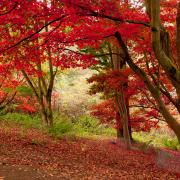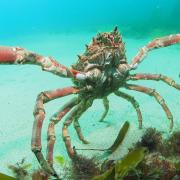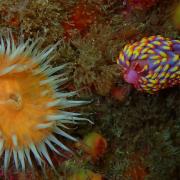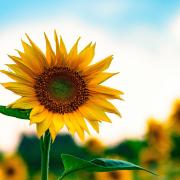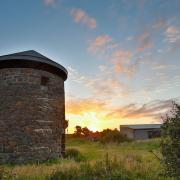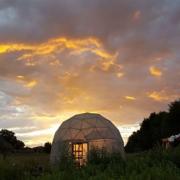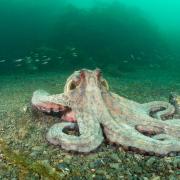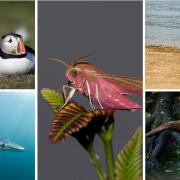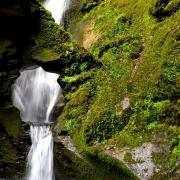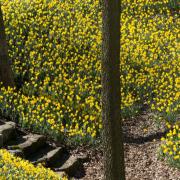Home is where the heart is - and at this time of year, for birds their nests are busy with the job of laying eggs and bringing up their young. DAVID CHAPMAN examines how we can help them

In April our garden birds will be busy with nesting, laying eggs and maybe even bringing up their young. So how can we help garden birds with these duties and make their lives easier?

For those birds which are already feeding young (this might include blackbirds and robins), we can provide food. Though the adult birds might be prepared to eat bird seed at this time of year these birds will be looking for high protein food such as worms and grubs to feed to their chicks. To help we can put out mealworms for them - that will be doing them a real favour, but be careful, it might cost you a fortune!
Some birds will be making their nests during April and we can do two things to help them. Firstly continue to put out bird feeders we will be providing them with food which will save them time and energy allowing them to get on with nest-making. Some people warn against feeding birds in the spring and summer but it is safe to feed them so long as you don’t put out too much food which might be left over and rot or attract rats. Don’t put out whole peanuts which adult birds might then try to feed to their young with tragic consequences.
Secondly we can provide suitable nesting material for the birds. I put out dog’s hair and sheep’s fleece in old peanut feeders, I also leave bits of grass, leaves and twigs in parts of the garden where the birds can collect them from.
In the longer term we can make nest boxes. People will say that spring is the wrong time of year to put out nest boxes, well I think that’s nonsense! There isn’t a wrong time to put up nest boxes. If you put them up now they probably won’t be used this year but birds will inspect them and there is a better chance of them being used next spring. So make a nest box and put it up.
Before making, or buying, a nest box you need to think carefully about which species you are likely to attract. In my garden I have only three species which use my nest boxes, they are great tit, blue tit and house sparrow. On my smallholding I also have a pair of tawny owls in a box. Other species you may attract to nest boxes in your gardens include woodpecker and nuthatch if you live near woodland. There is no point in making a nest box designed for a species which you are not going to attract.
All of the birds in my garden use nest boxes with a hole in the front, the size of the hole varies according to the species (about 25mm is plenty big enough for tits, up to about 32mm for house sparrows and nuthatches and 50mm for great spotted woodpeckers). Generally nest boxes should be made of thick wood (an inch thick is good) for insulation and the holes should not face the south west (where the worst rain comes from). For house sparrows you need several boxes because they nest in colonies and they need to be under the eaves of the house, for tits they can be single and should be on tree trunks or posts at about head height.
Another species which you might get in a hole-fronted nest box in Cornwall is the pied flycatcher. This would be an exciting one to attract because it only breeds in very small numbers in the county and is generally only found in the east of Cornwall and in deciduous woodland. It is a species which will use nest boxes quite readily and the provision of nest boxes has helped it to spread from its stronghold in Wales across Somerset and Devon.
I have never had any birds nesting in the open-fronted nest boxes in my garden so they were a waste of time for me. The bird which I really hoped to attract with open-fronted nest boxes was the spotted flycatcher, a bird which is found in small numbers across the county. Some commoner birds such as robins and pied wagtails will sometimes use open-fronted boxes but in my experience they prefer natural nest sites so in the longer term it is best to think about how you use your garden and what you plant there.
The best places for birds to nest are in climbers. Our native climber, the ivy, is fantastic. It creates a dense thicket of vegetation which protects the nest from the elements and predators. Ivy isn’t everyone’s favourite plant but you might be able to find a corner of the garden where you can let it grow. We have some growing against our garage wall and in there I have had wren, blackbird, dunnock, robin and song thrush nesting.
If you don’t like our native ivy then try buying a variegated variety but try to choose one which produces berries in the winter as these are also valuable to garden birds. We also have a wisteria growing up the side of our house, in here we have had blackbirds nesting in several seasons but I am longing for the day that we attract spotted flycatchers to nest there! These flycatchers love nesting in climbers on the walls of houses so think long-term and get a wisteria.
Last year we had a pair of collared doves nesting in a vine growing over a pergola. It’s strange how well-hidden a pair of large birds can remain and their youngsters were remarkably quiet, unlike their parents.
Apart from climbers birds will nest in a variety of places. Dense shrubs are ideal for many birds. Swallows like to nest inside buildings or in porches so think about leaving a window open in a shed, but make sure you can leave it open for the whole summer. Pied wagtails and robins will nest in holes in walls, my neighbour once had a garage in which there was a hole in the wall at about head height and a pair of pied wagtails used that to nest in for one season.
So it is possible to design and plant your garden to provide birds with places to nest and it is also possible to plan where they might find material to nest with.
Apart from leaving untidy areas where birds can find twigs, leaves and bits of grass there are also plants which they can collect nesting material from. Our house sparrows, for example, love pampas grass. If you have a pond you could try bulrushes, though this is not advisable if your pond has a liner because the roots of bulrushes can penetrate liners. Mosses are very useful to many birds when making nests so I leave moss to grow in my lawn.
So there are many ways in which we can help birds to be successful in raising their young whilst getting great enjoyment out of watching them and satisfaction from knowing we have been a part of their success.








